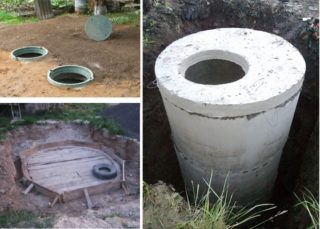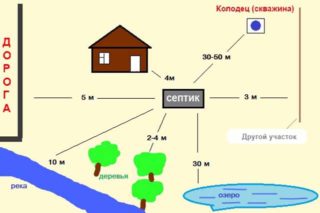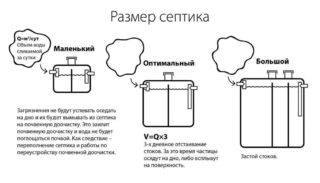The presence of an autonomous sewage system in a suburban area makes living in a house comfortable, comparable to staying in a comfortable apartment. At the same time, it is important to take care of the final receiver of fecal / domestic wastewater, for example, to make a reliable cesspool in the country with your own hands. The functionality of the collector depends on how correctly it is designed and installed.
Types and arrangement of cesspools for summer cottages

The final receiver of fecal matter can be:
- Cesspool leaky pit. It is a reservoir formed directly in the ground. It is assumed that the wastewater will enter it and then be periodically pumped out. However, there are several problems. First, such a receiver causes irreparable harm to the environment. Runoff seeping into the ground gets into groundwater, seriously undermining the ecological situation in the region. Therefore, a law of the Russian Federation was adopted on criminal liability for the construction of such wells. Secondly, the earthen bottom silts up over time, which leads to the rapid filling of the pit. It has to be pumped out more often.
- Sealed cesspool. It is also formed in the ground, but it is pre-concreted from all sides or laid out with bricks. Sometimes any volumetric tank (barrels, polymer cubes, etc.) is used as a sealed receiver.
- The overflow septic tank is a complete purification system. Works on the principle of gradual wastewater treatment. Consists of two or three chambers. The former are sealed, the latter with a drainage bottom. Fecal water enters the first receiver, settles, due to which large debris settles to the bottom, light debris floats to the surface. Clarified water is poured into the second chamber and settled according to the same principle. Then, even more purified water goes into the third chamber, where it is already drained into the soil.
The drains clarified in a septic tank are safe for the soil, since the percentage of their purification is from 85%.
Regulatory Requirements
- The pit is placed at the lowest point of the site so that fecal water moves to it by gravity.
- The receiver is removed from the house at least 5 meters, but the further the better.
- From sources of drinking water (own and neighboring), the pit is mounted at a distance of 25 meters or more.
- The volume of the tank according to SNiP is derived from the calculation of 200 liters of water per one family member per day. On average, for three people, you can mount a pit of 3-4 m3.
- It is advisable to leave a place for the entrance to the waste disposal equipment receiver.
When constructing a pit with a drainage bottom, it is important that the groundwater level in the area is at least 1 meter below the level of the base of the receiver. Otherwise, according to sanitary standards, it is forbidden to arrange such a pit for a toilet and other plumbing facilities.
Designing and carrying out the necessary calculations
To build a pit correctly, you need to calculate everything accurately. First of all, the volume of the future reservoir is calculated. It is taken out according to the average recommended rates of 1.5-2 m3 per family member.
You need to calculate the parameters / size of the receiver (depth and width). The depth depends on the groundwater level. The higher they are, the shallower and wider they make the pit.To the obtained depth, add 30 cm for a sand cushion and concrete fill or for a drainage bottom device.
Here you need to calculate the number of bricks for laying walls. The height of the walls is divided by the height of one brick plus 6 mm (the height of the masonry joint). Thus, the number of rows of masonry is obtained. Next, you need to find out how many blocks are in one row. To do this, its length is divided by the width of the brick. The result is the total number of masonry blocks.
The neck of the tank must be raised 20-30 cm above ground level to prevent flooding by flood waters.
Necessary tools and materials for work
For the device of a cesspool without pumping out in the country, you need to prepare the following tools and materials:
- brick for laying out the walls of the drain receiver (can be replaced with a plastic cube / barrel without a bottom, concrete rings);
- river sand;
- coarse crushed stone;
- quarry, broken brick or large river stone;
- shovel;
- pegs and control cord;
- roulette;
- cement and sand for mortar preparation;
- concrete mixer or pallet;
- hatch cover.
You also need to stock up on a ladder, bucket, pickaxe and trowel.
Self-assembly of a cesspool in the country
A trench 15 cm wide and 15 cm deep is dug along the bottom perimeter. This will be the foundation for the receiver walls. A formwork made of thin boards is placed in it. A solution is prepared from crushed stone, sand and cement in a ratio of 6: 4: 1. The ready-made composition is poured into the formwork and wait for it to dry.
Brick laying is made on the frozen foundation, leaving a hole for the inlet of the sewer pipe. Finished walls can be additionally plastered with masonry mortar.
Arrange a drainage bottom. First, a layer of river sand 10 cm thick is poured. Fine crushed stone is placed on top. The top layer of drainage is broken brick or river stone.
The top of the receiver is covered with concrete slabs or metal sheets. Leave a hole for the hatch. The edges of the slabs, sheets should protrude beyond the perimeter of the receiver by 30 cm. From above, everything is covered with turf, soil or just roofing material.
It is advisable to insulate the pit hatch so that the cold does not freeze the drains in the winter, and in the summer the stench does not ooze from the receiver. It is possible to reduce the level of pumped waste if, in the warm season, special bacteria are loaded into the pit for processing fecal water.
Common construction mistakes
Frequent mistakes when constructing a pit for household drains:
- Incorrectly defined tank volume. If it is too small, you will often have to pump out water, spend the family budget.
- Incorrectly positioned inlet of the sewer pipe (at the bottom or in the middle of the pit). It is always located in the top quarter of the receiver.
- The location of the cesspool at the top of the site. The drains will not be able to get here by gravity.
- Lack of reinforced receiver walls. As a result, the soil can crumble, and dirty water seep into underground streams.
If you take these common mistakes into account and do everything right, a good reservoir can only be pumped out every six months, and even less often when using bacteria. Sludge, which will be formed under their influence, can then be used as compost.










